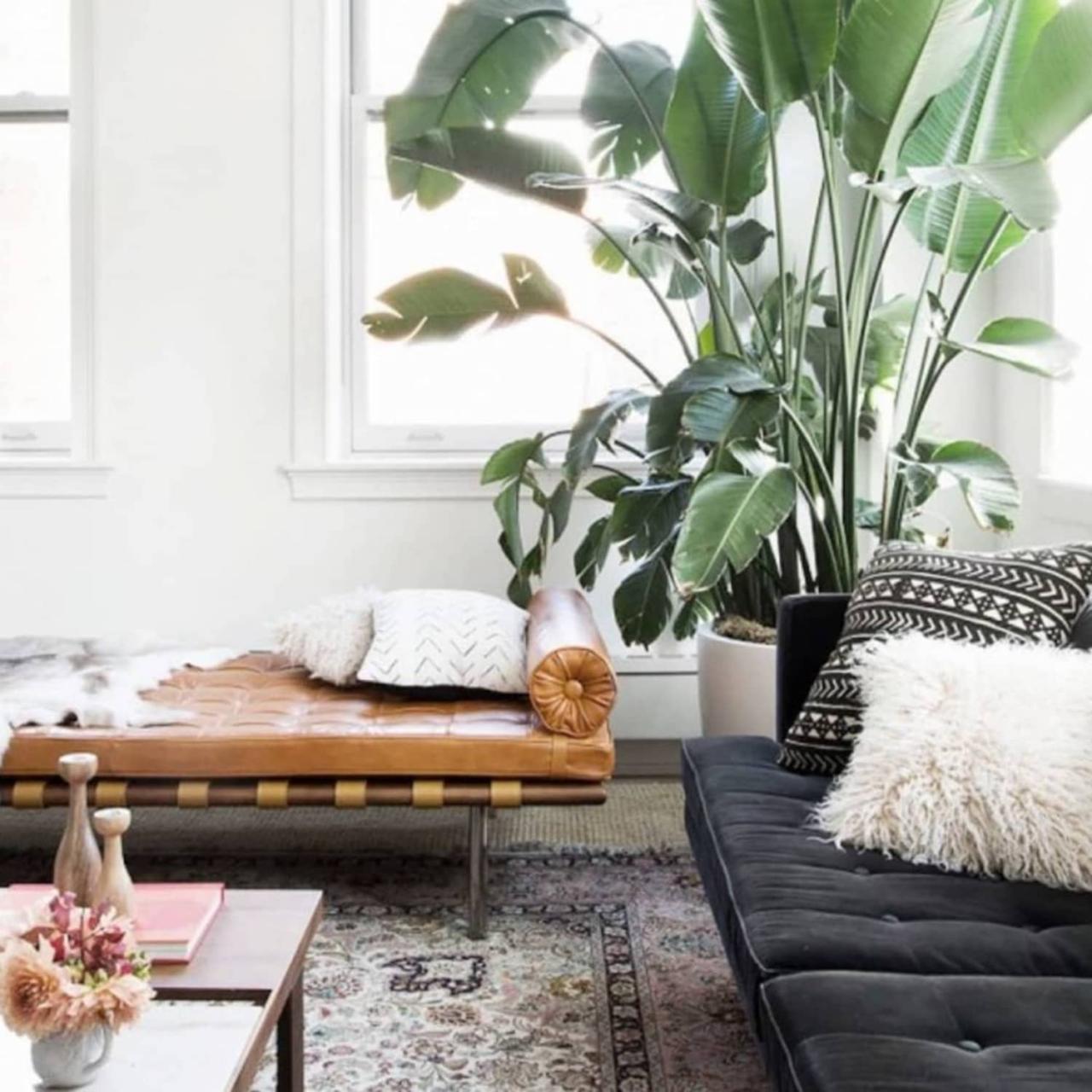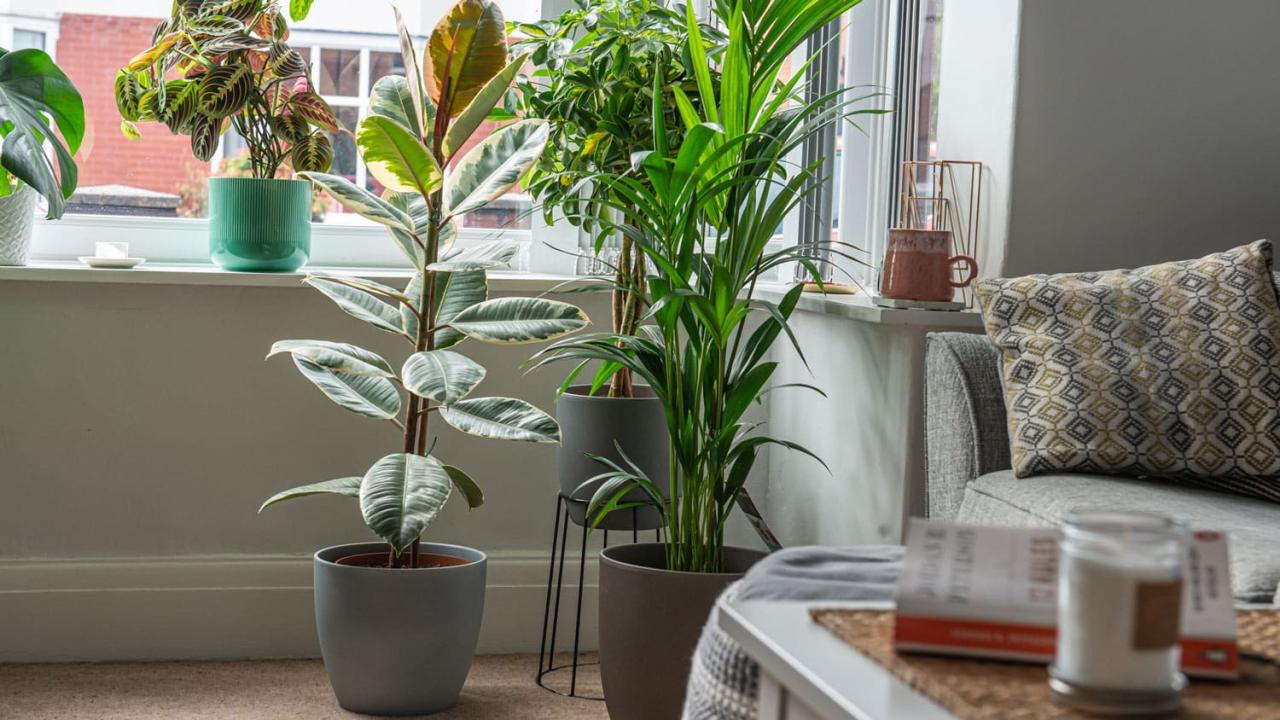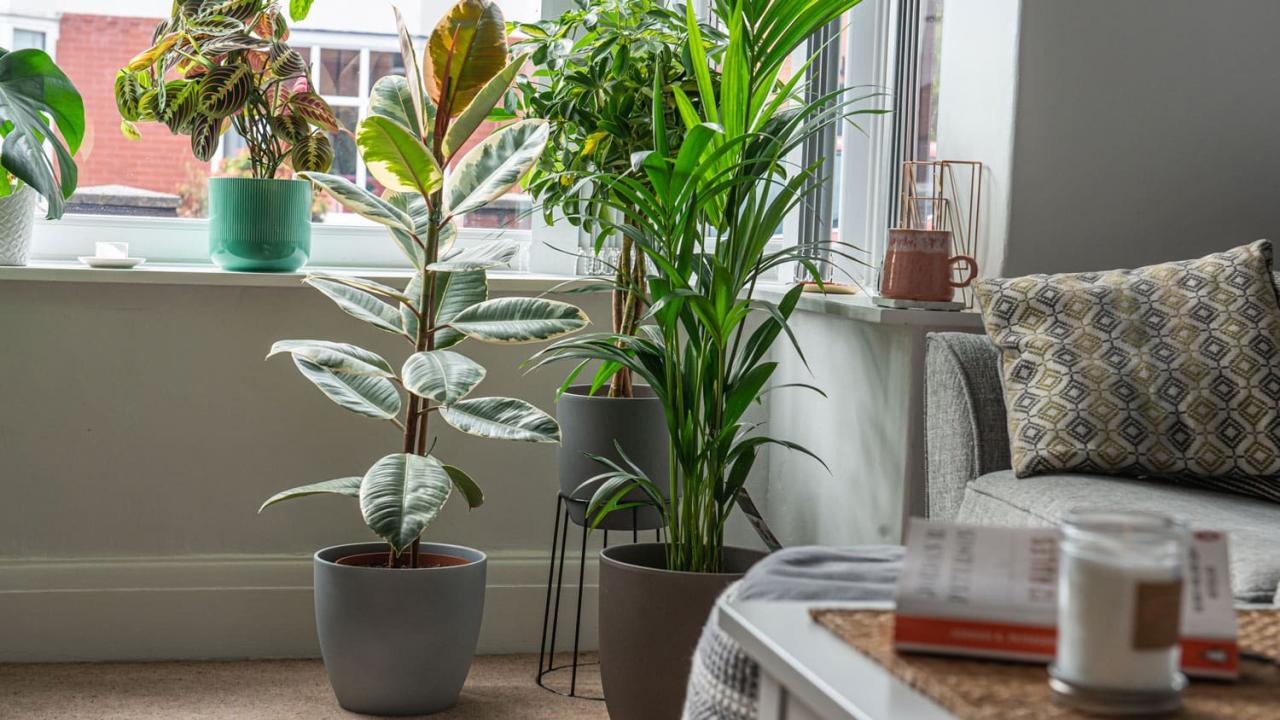The Pros and Cons of Having Large Indoor Plants: Bringing the outdoors in has become a popular trend, with many homeowners opting for large indoor plants to enhance their living spaces. These botanical giants offer a multitude of benefits, from aesthetic appeal and air purification to psychological well-being.
However, their size also presents unique challenges, such as maintenance demands, space constraints, and potential safety concerns. This article explores the advantages and disadvantages of incorporating large indoor plants into your home, providing a comprehensive guide to help you make informed decisions.
From the lush foliage of a monstera deliciosa to the towering majesty of a fiddle leaf fig, large indoor plants can transform a room, adding a touch of nature’s beauty and creating a sense of tranquility. Their presence can elevate the ambiance, offering a sense of peace and serenity.
But before you bring home a botanical behemoth, it’s crucial to consider the practicalities of caring for such a large plant. Factors like sunlight requirements, watering schedules, and potential pests must be carefully assessed. Additionally, the sheer size of these plants can impact the available space in your home, potentially creating a sense of clutter or posing safety hazards.
Aesthetic Benefits

Large indoor plants are more than just green companions; they are powerful tools for enhancing the visual appeal of any space. Their presence transforms sterile interiors into vibrant, inviting environments, adding depth, texture, and a touch of nature’s beauty.
Impact of Texture and Color
Large indoor plants bring a unique textural element to indoor environments. Their leaves, stems, and even their pots can create a visually interesting contrast against smooth surfaces like walls and furniture. The diverse range of leaf shapes, from broad and rounded to slender and spiky, adds depth and dimension to a room.
The colors of large indoor plants also play a significant role in creating a visually appealing space. From deep greens to vibrant reds and purples, these plants offer a spectrum of hues that can complement or contrast with existing décor.
Specific Plants with Striking Visual Impact
- Fiddle Leaf Fig (Ficus lyrata): With its large, violin-shaped leaves, the fiddle leaf fig commands attention. Its bold, sculptural form adds a dramatic touch to any room.
- Monstera Deliciosa:The monstera deliciosa is known for its large, deeply lobed leaves that resemble a Swiss cheese plant. Its tropical aesthetic brings a touch of the exotic to indoor spaces.
- Bird of Paradise (Strelitzia reginae): The bird of paradise plant boasts vibrant orange and blue bracts that resemble the beak and crest of a tropical bird. Its striking colors and unique form make it a standout feature in any room.
Types of Large Indoor Plants and Their Aesthetic Qualities
Plant Name |
Aesthetic Qualities |
|---|---|
Fiddle Leaf Fig (Ficus lyrata) |
Dramatic, sculptural, bold foliage |
Monstera Deliciosa |
Tropical, exotic, deeply lobed leaves |
Bird of Paradise (Strelitzia reginae) |
Vibrant, colorful, unique bracts resembling a tropical bird |
Snake Plant (Sansevieria trifasciata) |
Geometric, upright, architectural, low-maintenance |
Peace Lily (Spathiphyllum) |
Elegant, graceful, white flower spathes, air-purifying |
Rubber Tree (Ficus elastica) |
Classic, versatile, large glossy leaves, easy to care for |
Air Quality Improvement

Large indoor plants can significantly contribute to improving the air quality within your home. They act as natural air purifiers, absorbing harmful pollutants and releasing clean oxygen.
The Process of Air Purification
Plants purify the air through a process called phytoremediation. This involves the absorption of pollutants through their leaves and roots. The pollutants are then broken down and metabolized within the plant’s tissues. The breakdown of pollutants can occur through a variety of mechanisms, including:
- Absorption:Pollutants are absorbed through the plant’s leaves and roots.
- Adsorption:Pollutants adhere to the plant’s surfaces, such as the leaves and roots.
- Biodegradation:The plant’s enzymes break down the pollutants into less harmful substances.
Pollutants Removed by Indoor Plants
Indoor plants can effectively remove various pollutants, including:
- Volatile Organic Compounds (VOCs):These are chemicals released from building materials, furniture, paints, and cleaning products. Common VOCs include formaldehyde, benzene, toluene, and xylene.
- Formaldehyde:This colorless gas is a common indoor pollutant found in furniture, carpets, and building materials.
- Benzene:This colorless liquid is emitted from paints, glues, and detergents.
- Toluene:This colorless liquid is emitted from paints, varnishes, and glues.
- Xylene:This colorless liquid is emitted from paints, varnishes, and glues.
- Carbon Dioxide (CO2):This gas is naturally present in the air and is produced by human respiration and combustion.
- Dust and Particulate Matter:These are small particles that can be inhaled and cause respiratory problems.
Comparison of Air-Purifying Capabilities
Different plant species have varying levels of effectiveness in removing specific pollutants. Some notable examples include:
- Snake Plant (Sansevieria trifasciata): Highly effective at removing formaldehyde, benzene, toluene, and xylene.
- Peace Lily (Spathiphyllum wallisii): Known for its ability to remove formaldehyde, ammonia, and trichloroethylene.
- English Ivy (Hedera helix): Effective at removing formaldehyde, benzene, and toluene.
- Spider Plant (Chlorophytum comosum): Removes carbon monoxide, formaldehyde, and xylene.
- Weeping Fig (Ficus benjamina): Known for its ability to remove formaldehyde and benzene.
Common Indoor Pollutants and Effective Plants
Pollutant |
Effective Plants |
|---|---|
Formaldehyde |
Snake Plant, Peace Lily, English Ivy, Spider Plant, Weeping Fig |
Benzene |
Snake Plant, English Ivy, Weeping Fig, Devil’s Ivy (Epipremnum aureum), Bamboo Palm (Chamaedorea elegans) |
Toluene |
Snake Plant, English Ivy, Spider Plant, Devil’s Ivy |
Xylene |
Snake Plant, Spider Plant, Devil’s Ivy, Weeping Fig |
Ammonia |
Peace Lily, Snake Plant, ZZ Plant (Zamioculcas zamiifolia) |
Trichloroethylene |
Peace Lily, Spider Plant, Devil’s Ivy |
Carbon Dioxide |
Spider Plant, Snake Plant, Weeping Fig |
Psychological Benefits
Large indoor plants are not only aesthetically pleasing and beneficial to air quality but also offer significant psychological advantages. Bringing nature indoors can positively impact mental well-being, creating a more calming and restorative environment.
Large indoor plants offer a unique aesthetic appeal and air-purifying benefits. However, they can also demand significant space and care. Choosing the right plant stand is crucial for supporting these large plants, ensuring their stability and showcasing their beauty. For those seeking to enhance their interior design with large plants, Best Plant Stands for Large Indoor Plants provides a comprehensive guide to finding the perfect stand for your green companions.
By carefully selecting the right stand, you can effectively balance the pros and cons of large indoor plants, creating a vibrant and harmonious living space.
Impact on Mental Well-being
Research indicates that being around plants can reduce stress, anxiety, and improve focus. The presence of greenery in indoor spaces can create a sense of tranquility and peace, promoting relaxation and a feeling of connection to nature. The act of caring for plants can also be therapeutic, providing a sense of purpose and accomplishment.
Stress Reduction and Anxiety Relief
Studies have shown that spending time in nature or even simply viewing images of nature can significantly reduce stress levels and promote relaxation. This effect is attributed to the calming influence of natural elements like plants, which can lower blood pressure, heart rate, and cortisol levels, all of which are associated with stress.
Improved Focus and Concentration
The presence of plants in indoor environments can enhance focus and concentration. Studies have shown that individuals working in offices with plants experience improved cognitive function and reduced fatigue. The visual stimulation and the calming effect of greenery can help create a more conducive environment for cognitive tasks.
Plant Species and Psychological Benefits
Plant Species |
Psychological Benefit |
|---|---|
Peace Lily (Spathiphyllum) |
Reduces stress and anxiety, promotes relaxation |
Snake Plant (Sansevieria trifasciata) |
Improves air quality, promotes tranquility and calmness |
Spider Plant (Chlorophytum comosum) |
Enhances focus and concentration, reduces fatigue |
ZZ Plant (Zamioculcas zamiifolia) |
Boosts mood, promotes a sense of well-being |
Maintenance Considerations

While large indoor plants offer numerous benefits, they also demand a significant commitment in terms of care and maintenance. The size and complexity of these plants necessitate a greater understanding of their specific needs and a more proactive approach to ensure their continued health and vitality.
Sunlight Requirements
Large indoor plants often require substantial amounts of sunlight to thrive. Understanding their individual light needs is crucial. Plants like Fiddle Leaf Figs, Monsteras, and Rubber Trees prefer bright, indirect light, while others, such as Snake Plants and ZZ Plants, tolerate low-light conditions.
However, even low-light tolerant plants benefit from some exposure to sunlight.
- Bright, Indirect Light:Place these plants near a window that receives ample sunlight but avoid direct sunlight, which can scorch their leaves. Rotate the plant regularly to ensure even light exposure on all sides.
- Low Light:These plants can tolerate lower light levels but may not grow as vigorously. Consider supplementing with artificial light sources, especially during winter months when natural light is limited.
Watering Needs, The Pros and Cons of Having Large Indoor Plants
Large indoor plants generally require more frequent watering than smaller ones. However, overwatering can be detrimental, leading to root rot and other issues. The frequency of watering depends on various factors, including the type of plant, the size of the pot, the surrounding temperature, and humidity levels.
- Watering Frequency:Check the soil moisture before watering. If the top inch of soil feels dry, it’s time to water. Water thoroughly, allowing excess water to drain out of the drainage holes.
- Signs of Overwatering:Yellowing leaves, wilting, and a foul odor from the soil are all indicators of overwatering. Allow the soil to dry out completely before watering again.
- Signs of Underwatering:Dry, brittle leaves, wilting, and leaf drop are signs of underwatering. Water the plant deeply and allow the soil to drain.
Nutrient Requirements
Large indoor plants consume more nutrients than smaller plants. Over time, the soil in their pots can become depleted of essential nutrients, leading to stunted growth and weakened plants. Regular fertilization is crucial to replenish these nutrients.
- Fertilizer Types:Liquid fertilizers are easy to use and readily absorbed by plants. Granular fertilizers are slow-release and can be applied every few months. Choose a fertilizer specifically designed for indoor plants.
- Fertilization Frequency:Fertilize your plants during the growing season (spring and summer) every 2-4 weeks. Reduce fertilization frequency during the winter months when plants are dormant.
Potential Issues
Large indoor plants are susceptible to various issues, including pests, diseases, and root rot. Early detection and prompt treatment are essential to prevent these problems from becoming severe.
Large indoor plants offer a myriad of benefits, including improved air quality and a sense of tranquility. However, their size can also present challenges, such as finding the right spot and providing adequate care. One popular choice for indoor greenery is the money plant, known for its hardiness and ability to thrive in various conditions.
For optimal money plant care throughout the year, check out these expert tips , which can help ensure your large indoor plant thrives. When choosing a large indoor plant, it’s crucial to weigh the pros and cons carefully, considering both its visual impact and the commitment required for its long-term well-being.
Pests
Common pests that can infest large indoor plants include:
- Spider Mites:These tiny pests spin webs on the underside of leaves and suck sap from the plant, causing yellowing and browning.
- Mealybugs:These soft-bodied insects leave behind a white, cottony residue on leaves and stems.
- Scale Insects:These insects attach themselves to the plant and suck sap, leaving behind a sticky substance.
Diseases
Large indoor plants can also be susceptible to various diseases, including:
- Leaf Spot:Fungal or bacterial infections that cause spots on leaves.
- Root Rot:A fungal disease that occurs when soil is constantly wet.
- Powdery Mildew:A fungal disease that creates a white, powdery coating on leaves.
Root Rot
Root rot is a common problem in large indoor plants, especially those that are overwatered. Symptoms of root rot include wilting, yellowing leaves, and a foul odor from the soil.
- Prevention:Allow the soil to dry out between waterings and avoid overwatering. Choose pots with drainage holes and use well-draining potting mix.
- Treatment:If root rot is suspected, remove the plant from its pot and inspect the roots. Trim away any soft, mushy, or black roots. Repot the plant in fresh, well-draining potting mix and water sparingly.
Maintenance Guide
Here’s a guide to help you maintain your large indoor plants:
- Regularly inspect your plants for signs of pests, diseases, and root rot.
- Water your plants thoroughly when the top inch of soil feels dry.
- Fertilize your plants during the growing season with a balanced fertilizer designed for indoor plants.
- Repot your plants when they become root-bound, typically every 1-2 years.
- Provide adequate sunlight for your plants, based on their individual needs.
- Maintain a consistent humidity level, especially for tropical plants.
- Clean leaves regularly to remove dust and debris.
- Be patient and observant. Learn to understand the unique needs of your plants and respond accordingly.
Troubleshooting Common Problems
Here are some common problems and their solutions:
- Yellowing Leaves:This can be caused by overwatering, underwatering, nutrient deficiencies, or pests. Check the soil moisture, fertilize the plant, and inspect for pests.
- Wilting:This can be caused by underwatering, overwatering, or root rot. Check the soil moisture and inspect the roots.
- Leaf Drop:This can be caused by stress, such as changes in temperature, humidity, or light levels. Adjust the plant’s environment accordingly.
- Brown Spots on Leaves:This can be caused by sunburn, overwatering, or pests. Move the plant away from direct sunlight, check the soil moisture, and inspect for pests.
Conclusion
While large indoor plants can offer a wealth of benefits, it’s essential to weigh the pros and cons before making a commitment. By carefully considering your lifestyle, available space, and commitment to care, you can determine whether a large indoor plant is the right fit for your home.
Remember, a little research and planning can go a long way in ensuring a harmonious and enriching relationship with your leafy companion.
Top FAQs: The Pros And Cons Of Having Large Indoor Plants
How often should I water my large indoor plant?
Watering frequency depends on the plant species, pot size, and environmental factors. Check the soil moisture regularly and water when the top inch of soil feels dry. Avoid overwatering, as this can lead to root rot.
What are some common pests that affect large indoor plants?
Common pests include spider mites, mealybugs, aphids, and scale. Regularly inspect your plants for signs of infestation and use appropriate pest control methods if necessary.
Where can I find large indoor plants for sale?
You can find large indoor plants at local nurseries, garden centers, online retailers, and even some home improvement stores.
